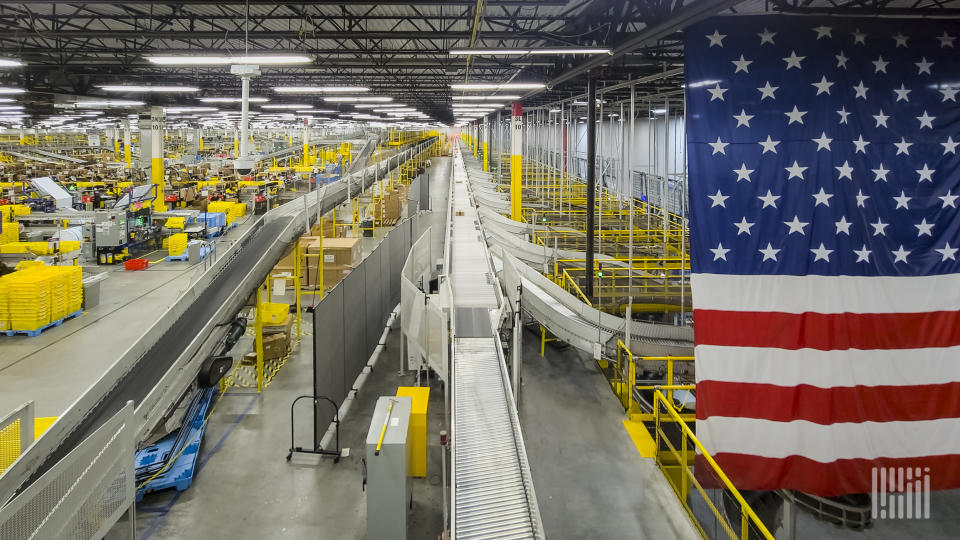Logistics warehouse automation to continue apace despite construction slowdown

After two years of off-the-charts expansion, the U.S. logistics warehouse market began slowing in 2022. It declined more precipitously in 2023 as higher costs of capital and waning end-user demand took their toll. Investments in warehouse automation have followed a similar path, with contracting order levels and more prolonged sales cycles through 2023 and into 2024.
“Given the inflationary environment and resulting high interest rates (which aren’t due to come down anytime soon), we expect a relatively sluggish 2024 with limited order intake growth,” said Reuben Scriven, research director at Interact Analysis, a U.K.-based industrial research firm, referring to the global warehouse automation market in a report.
However, no one expects the warehouse construction downcycle to last very long due to continued e-commerce demand and retailers’ desire to hold more buffer stock in order to avoid supply chain disruptions. The multiyear outlook for automation is also bullish as companies look to ramp up efficiencies while offsetting what is expected to be a shortage of human labor in the facilities.
Warehouse automation investments will continue apace regardless of the macro environment, said Brewster Smith, head of supply chain solutions, occupier services/Americas for Colliers, a global real estate services firm (NASDAQ: CIGI). “If a company can materially reduce its operating expenses and/or increase the number of orders they can process in a given work day, a client will move forward with the investment” no matter the state of the broader economy, he said.
Colliers helps clients determine what type of automation works best for their operating models, Smith said. The firm then sources the appropriate vendor through an RFP bid process, he said.
According to a global survey published earlier this year by materials handling trade group MHI and consultancy Deloitte, 74% of supply chain leaders are increasing their supply chain technology and innovation investments. About 90% said they plan to spend over $1 million, an increase of 24% over last year. About 36% plan to spend over $10 million, up 19%. These investments include solutions for improved supply chain resiliency, transparency and sustainability as well solutions for the ongoing workforce shortage. The report did not highlight automation investments in particular.
Knowing the value of automation is one thing. Embedding it in facilities that are decades old is another. For example, most legacy U.S. warehouses are 30 feet high, which generally makes them unsuitable for the installation of a conventional Automated Storage and Retrieval System (ASRS) that needs to be 40 feet or higher, according to Smith.
In addition, the floors that support ASRS must be completely level, ruling out facilities where concrete may have been poured 30 years ago, Smith said. Neil Shelton, chief strategy officer of contract logistics giant GXO Logistics Inc. (NYSE: GXO), said it’s critical for a facility’s concrete slab to be able to absorb the additional weight of new equipment. However, certain automation like collaborative robots — machines that work alongside humans in the warehouse — are not heavy enough to damage existing slabs.
One of the biggest challenges for warehouse users and specialists like GXO that have invested heavily in automated facilities is sorting through the myriad technologies and vendors hawking them, said Shelton. “There are hundreds of suppliers, and there are so many technologies out there to incorporate,” he said. GXO has estimated that a third of its revenue comes from large-scale automation projects, compared with less than 10% across the rest of the industry.
Understanding how to prep a legacy facility before retrofitting for automation is often overlooked by first-time automation users in their rush to quickly embed technology into the building, said Jamie Dorland, construction executive at Caddell Construction, a Montgomery, Alabama-based general contracting and construction management firm that has retrofitted 15 major warehouses in the past six years. Users and their robotics vendors are often unaware of the changes that can potentially disrupt a facility’s normal work and product flow, he said. Caddell is contracted out to the tenant and not the technology vendor, though it works more closely with the technology side than it has in the past.
The four core infrastructure modifications involve electrical, compressed air, concrete and fire protection systems, according to Dorland. Of those, necessary electrical shutdowns cause the most user anxiety because they threaten to reduce productivity, he said. In addition, many legacy warehouses lack the spare capacity to accommodate more robust systems. As a result, new utilities need to be brought in and established, he said.
The integration of the new systems requires a temporary operational shutdown, Dorland said. As a result, each step must be carefully coordinated with existing operations to ensure that they can maintain regular operations and schedule shifts accordingly, he said.
Smith of Colliers said it’s critical that occupiers verify that their existing power supply is sufficient to accept the planned automation solution. “Occupiers may have to redesign their [warehouse] rack layout to accommodate a new solution, but this should not be a barrier to entry. Automation typically offers a demonstrable step-change in productivity so a rack redesign would be well worth the effort.”
Questions about ROI would arise if a brand-new facility should be required, which would generally be the case if an ASRS were being installed, Smith said. “We are seeing a lot of clients adopting partial automation solutions like collaborative robots without having to move from one building to another,” he said.
The post Logistics warehouse automation to continue apace despite construction slowdown appeared first on FreightWaves.
